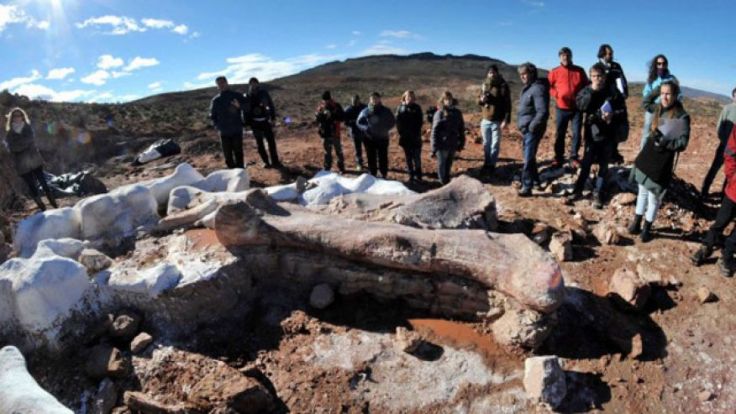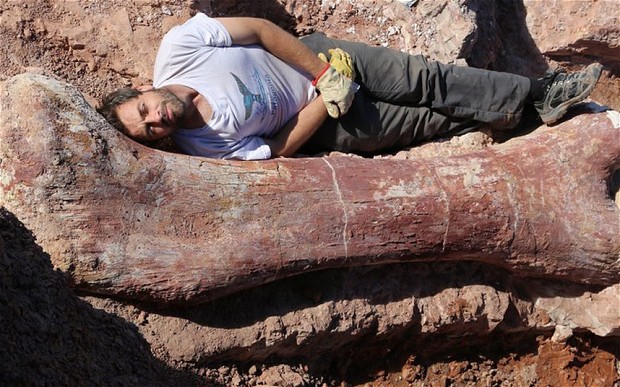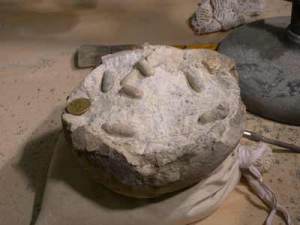
What is the largest animal to have ever lived on the Earth? Most people will answer “dinosaurs” or “sauropods” in particular. While some titanosaurs may have been the heaviest land animals they were not the largest animals to have lived on Earth. That distinction goes to an animal that is very much alive today: the blue whale. At 190 short tons (380,000 pounds!) blue whales are massive animals that make most dinosaurs look positively puny.
Just how do dinosaurs compared to these true giants? Well, possibly the largest dinosaur ever was discovered in the Patagonia region of Argentina in 2014. Seventy percent of the bones of one individual have now been excavated and a replica of the dinosaur has just been unveiled at the Natural History Museum in New York. Estimated to be 122 feet long and weighing 170,000 pounds it would have been much longer than a blue whale but only half of the total weight of a blue whale. Nonetheless this new dinosaurs is impressive especially when one considers that it had to lug its huge frame around on land.
The enormity of the dinosaurs is hard to imagine even considering the size of whales. Just consider that even the largest dinosaurs were born from eggs probably not much larger than an ostrich egg (see my article Giant Dino Eggs Found? Bad Reporting on Bad Science for an explanation). How could they have held up that much weight? How did they get enough oxygen through the entire body? The public is fascinated by their size, scientists are fascinated by their biology and pursue answers to these and a hundred other questions about dinosaurs. These factors keep the interest level in dinosaurs very high and the discoveries pouring in on a nearly daily basis.

This new dinosaur is a new species of Titanosaurus. Titanosaurs are a kind of plant-eating long-necked sauropod that lived mostly in the Jurassic Age. Titanosaurs have already been found in Argentina, Antarctica, and Europe but these new specimens are the largest species of Titanosaurus yet. This new find isn’t just of one new individual but rather seven Titanosaurs all together in one location. Researchers suggest they died together possibly stuck in some mud or huddled together in a storm. But after their death it seems pretty clear what happened. A number of T-rex-like carnivores scavenged the bodies. We know this because mixed in with the Titanosaurus bones were 60 carnivore teeth likely lost while trying to bite through the tough skin of the herbivores.
You might think of T. rex as being a huge dinosaur and fearsome warrior. Yes, there were impressive but that doesn’t mean it could easily have overcome any prey. T. rex’s were the largest carnivore that we know of BUT the largest T. rex we know of was only 7 tons (14,000 pounds). Compare that to the Titanosaurus at 70 tons and you can see that the T. rex would have had to have thought twice about attacking such a beast. Imagine the difference between a T. rex and a Titanosaurs as similar to the difference between a large carnivore such as a lion and a hippo, elephant or giraffe.

Another Titanosaurus Tidbit

Last year I wrote about Titanosaurs but that article was just about their eggs (Fossil Wasp Cocoons in Dinosaur Eggs: Evidence of a Complex Ecology). In fact it wasn’t so much about their eggs as it was what was found in some fossilized eggs. Some eggs have been found with fossilized wasp cocoons in them. This is a case where fossils can tell us about the ecology of the past. There are wasps today that lay their eggs in rotten or broken eggs and use that at a food source for their young. It seems that wasps have been doing this since the time of the dinosaurs. To the right is a picture of one of those eggs with the fossil cocoons inside. You can see that a Titanosaurus egg is not much bigger than eggs of large birds today. Imagine the size of a Titanosaurus just after it has hatched from an egg like this?
Links to other descriptions of this titanic discovery:
Scientists find largest dinosaurs Titanosaur fossil Daily Mail–Fossils of giant ‘Titanosaur‘ found in Argentina Fox NewsAs heavy as 14 elephants, as long as 2 tractor trailers: Meet Mr … CNN
‘Biggest dinosaur ever’ discovered BBC News–A Giant Among Dinosaurs Discovered In Argentina Blog–NPR (blog)
T. rex as scavenger isn’t really debated among theropod researchers. In fact, we have fairly conclusive evidence that T. rex was predatory. Check out Brian Switek’s rather annoyed post about the supposed debate on National Geographic’s Phenomena blog he shares with Carl Zimmer and a couple of others. It’s an entertaining read. http://phenomena.nationalgeographic.com/2013/07/16/time-to-slay-the-t-rex-scavenger-debate/
LikeLike
Thanks again for the info. I really don’t like propagating myths so I appreciate this correction. I was surprised to find that I had not read that article given that I am a regular follower of Zimmer. I’ve made the corrections in my post.
LikeLike
Is there any viable theory that explains how titanosaurs could reach such enormous sizes, despite growing from eggs so much tinier?
LikeLike
Although the spectacular finds in Argentina are getting the modern press, the largest dinosaur yet recorded comes from Colorado (my home, so I’m bragging). Unfortunately, only a few bones were found, and those in poor shape and the specimens lost since then.
Amphicoelias is the name, and frankly, we have almost no idea of how they could get so large!
LikeLike